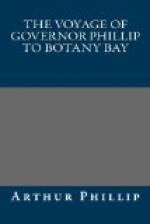When our settlers landed, there was not a single acre clear of wood in the island, and the trees were so bound together by that kind of creeping shrub called supple jack, interwoven in all directions, as to render it very difficult to penetrate far among them. The Commandant, small as his numbers were at first, by indefatigable activity soon caused a space to be cleared sufficient for the requisite accommodations, and for the production of esculent vegetables of all kinds in the greatest abundance. When the last accounts arrived, three acres of barley were in a very thriving state, and ground was prepared to receive rice and Indian corn. In the wheat there had been a disappointment, the grain that was sown having been so much injured by the weevil, as to be unfit for vegetation. But the people were all at that time in commodious houses; and, according to the declarations of Mr. King himself, in his letters to Governor Phillip, there was not a doubt that this colony would be in a situation to support itself entirely without assistance, in less than four years: and with very little in the intermediate time. Even two years would be more than sufficient for this purpose, could a proper supply of black cattle be sent.
Fish are caught in great plenty, and in the proper season very fine turtle. The woods are inhabited by innumerable tribes of birds, many of them very gay in plumage. The most useful are pigeons, which are very numerous, and a bird not unlike the Guinea fowl, except in colour, (being chiefly white,) both of which were at first so tame as to suffer themselves to be taken by hand. Of plants that afford vegetables for the table, the chief are cabbage palm, the wild plantain, the fern tree, a kind of wild spinage, and a tree which produces a diminutive fruit, bearing some resemblance to a currant. This, it is hoped, by transplanting and care, will be much improved in size and flavour.
But the productions which give the greatest importance to Norfolk Island are the pines and the flax plant, the former rising to a size and perfection unknown in other places, and promising the most valuable supply of masts and spars for our navy in the East Indies; the latter not less estimable for the purposes of making sail-cloth, cordage, and even the finest manufactures; growing in great plenty, and with such luxuriance as to attain the height of eight feet.* The pines measure frequently one hundred and sixty, or even one hundred and eighty feet in height, and are sometimes nine or ten feet in diameter at the bottom of the trunk. They rise to about eighty feet without a branch; the wood is said to be of the best quality, almost as light as that of the best Norway masts; and the turpentine obtained from it is remarkable for purity and whiteness. The fern tree is found also of a great height for its species, measuring from seventy to eighty feet, and affords excellent food for the sheep and other small cattle. A plant producing pepper, and supposed to be the true oriental pepper, has been discovered lately in the island, growing in great plenty; and specimens have been sent to England, in order to ascertain this important point.




